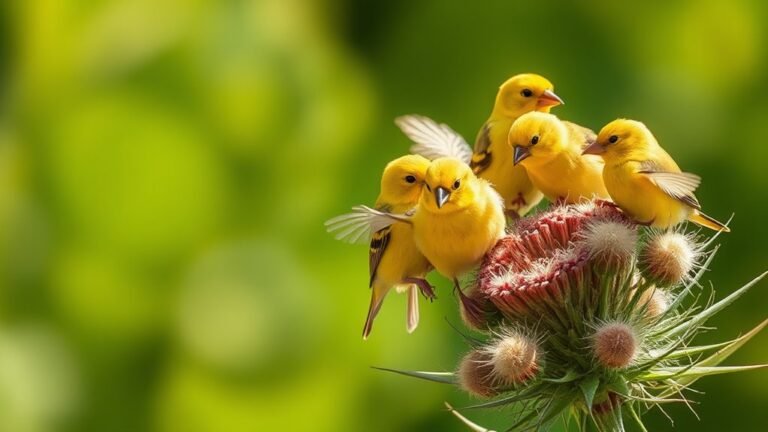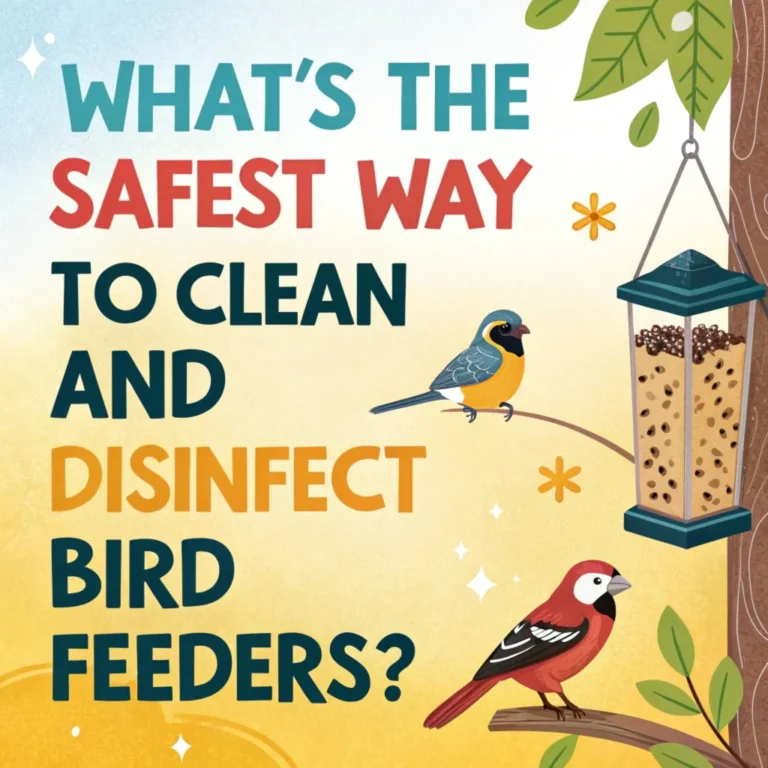Birds of Eastern North Carolina: Coastal and Inland Species
Eastern North Carolina features a variety of bird species across different habitats. Coastal areas attract shorebirds such as the Willet and Sanderling. Inland woodlands support birds like the Eastern Bluebird and Red-shouldered Hawk. This diversity enhances the environment and plays crucial roles in local ecosystems. Learning about these birds and their habitats shows the important relationships between them. What key factors affect their behaviors?
Key Takeaways
Eastern North Carolina has many diverse habitats that support various bird species. Coastal areas are home to birds like Willet, Sanderling, and Piping Plover. In inland regions, you can find Eastern Bluebird, Red-shouldered Hawk, and Great Egret.
Every season brings changes with migratory birds. For example, Red-cockaded Woodpeckers migrate south during winter.
Birdwatchers can visit key locations such as Alligator River National Wildlife Refuge, Hatteras Island, and Roanoke Island. These spots are known for unique bird sightings.
Conservation efforts are vital. They help protect the habitats that these coastal and inland birds need to survive. By supporting these initiatives, we can ensure these beautiful species thrive in Eastern North Carolina.
Overview of Eastern North Carolina's Avian Diversity

Eastern North Carolina features a diverse range of birds that delight birdwatchers and nature lovers. This area is a crucial stop for migratory birds, providing important resting places in coastal marshes and inland wetlands. These habitats support many bird species during their migrations.
Preserving these habitats is essential to keep these ecosystems healthy for future generations. As a birdwatcher, you can get involved in conservation efforts.
Every action matters and strengthens our connection to nature. By protecting these areas, you help maintain bird populations and their incredible journeys.
Enjoy the beauty of the varied birdlife, which enhances our enjoyment of nature and contributes to healthy ecosystems.
Coastal Bird Species
North Carolina's coastal habitats support many unique bird species. The mix of salt marshes, sandy beaches, and estuaries provides excellent living conditions for these birds.
Here, you can learn about shorebird identification. Bird watchers can recognize birds like the Willet and the Sanderling by their specific markings and behaviors. Many of these birds don't just pass through; they nest along the coast in peaceful dunes and marshes.
For example, spotting a piping plover resting in the grass highlights the importance of these ecosystems. Observing these birds helps you connect with nature and supports efforts to conserve their habitats.
Inland Bird Species

North Carolina's inland areas host a wide variety of bird species. These birds thrive in habitats such as forests, wetlands, and grasslands.
You can find woodland birds in dense thickets and wetland birds in marshes. Here are some species to watch for:
- Eastern Bluebird
- Great Egret
- Red-shouldered Hawk
- Northern Cardinal
Inland ecosystems depend on these birds. Each species adds to the natural beauty and sounds of the environment.
There's a vibrant community of birds waiting to be discovered beyond the coast. Enjoy exploring their world!
Migratory Patterns in Eastern North Carolina
Birds in Eastern North Carolina move between different areas throughout the year. Many embark on migratory journeys that affect local ecosystems and birdwatching.
Each spring and fall, various species travel along set routes to find breeding grounds or warmer weather. This movement alters the birdwatching experience as familiar birds leave and new ones appear.
For example, red-cockaded woodpeckers migrate south, while American kestrels return, adding color to the skies.
Habitats Supporting Birdlife

Diverse habitats in Eastern North Carolina support a wide range of birdlife. Various birds thrive in these areas, from the coastal shores to inland woods.
Here are some important habitats:
- Wetland Ecosystems: These areas provide essential breeding grounds for migratory birds.
- Forest Habitats: Forests offer shelter and food for many songbirds.
- Marshes and Swamps: These environments nurture a variety of species, creating lively ecosystems.
- Estuaries: Estuaries are crucial stopover points for many migrating birds.
All these habitats work together to support healthy bird populations.
By recognizing their importance, we can understand how nature connects and why we must protect these areas for future generations.
Enjoying birdwatching in these habitats can deepen your appreciation of wildlife and the environment.
Conservation Efforts for Birds
The habitats in Eastern North Carolina are vital for birds. We must focus on conservation efforts to protect these ecosystems.
Habitat preservation is essential. Wetlands, forests, and coastal regions play key roles in bird nesting and migration.
Participating in local initiatives can help protect bird species from habitat loss and climate change. You can get involved by joining conservation programs, supporting protective policies, and educating your community.
Every small action counts. Together, we can ensure future generations enjoy the rich bird diversity in this region and share the responsibility for their survival.
Best Birdwatching Locations
Eastern North Carolina has many great spots for birdwatching. Birdwatchers can see a variety of bird species in their natural surroundings.
Practicing good birdwatching ethics helps ensure a positive experience for everyone involved. Here are four top locations to consider:
- Alligator River National Wildlife Refuge – Here, you can see migratory waterfowl and shorebirds in expansive wetlands.
- Hatteras Island – This location offers a chance to view various coastal birds along beautiful shores and diverse ecosystems.
- Roanoke Island – Explore wooded areas and maritime forests, where you can find unique bird species while taking a leisurely walk.
- Pullen Park – This park hosts local birding clubs that organize events. Joining these events can help you connect with the community and share knowledge.
These locations provide a welcoming atmosphere for birdwatching enthusiasts!
Seasonal Birdwatching Tips
To improve your birdwatching experience through the seasons, invest in good birdwatching gear suitable for each time of year.
In spring, search for local nests. Use binoculars that provide a wide view to observe parent birds caring for their young.
During summer, look for colorful migratory birds. Choose lightweight gear to stay comfortable while watching.
As autumn arrives, pay attention to migrating patterns. Bring a notebook to record behaviors and notes about the birds you see.
Winter birdwatching can be enchanting. Dress warmly and carry a thermos filled with a hot drink to keep cozy.
Every season offers something special, allowing you to connect with nature and meet fellow birdwatchers.
Embrace these seasonal changes and deepen your appreciation for the birds of Eastern North Carolina.
Frequently Asked Questions
What Are the Best Times for Birdwatching in Eastern North Carolina?
To have a great birdwatching experience, plan your trips around migration times in spring and fall. Mornings and late afternoons are the best times to see a variety of birds. Keep an eye on seasonal patterns for the best chances to spot different species. Enjoy your time observing nature!
Which Bird Species Are Endangered in Eastern North Carolina?
In Eastern North Carolina, several bird species are endangered due to habitat loss. Conservation efforts aim to restore these habitats. These actions help protect vital ecosystems. Community engagement also supports the survival of these beautiful and vulnerable birds. By working together, people can play a crucial role in preserving these species for future generations.
Can I Feed Birds in My Backyard?
You can feed birds in your backyard. Set up bird feeders with seeds or nuts to attract them. You can also place fruits outside to provide natural food. Watching birds come and go is enjoyable and offers a chance to see their colorful interactions.
Are There Any Birdwatching Clubs in Eastern North Carolina?
Yes, there are several birdwatching clubs in Eastern North Carolina. These clubs organize events and meetups. They help people connect with each other and share their love for birds. Participants can improve their birdwatching skills together.
How Can I Identify Bird Calls in This Region?
To identify bird calls, focus on the unique rhythms and tones each bird makes. Listen carefully to these sounds. You can use sound identification apps to help recognize different patterns in their calls. Practice listening each day to improve your skills. With time, you will connect more with the lively sounds of birds around you. Enjoy the process and the beauty of nature!

Ava is a bird enthusiast and nature lover who has spent countless hours observing and learning about the fascinating world of birds. With a passion for sharing her knowledge and inspiring others to appreciate the beauty of birds, Ava writes about her experiences and insights on avianadmirer.com.







